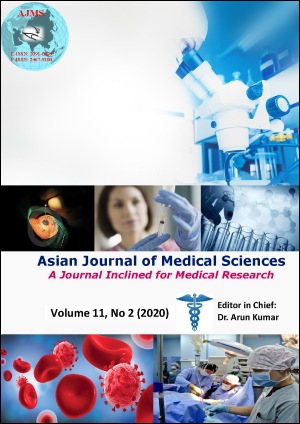Immunoexpression of p53 and ki-67 correlated with clinicopathological parameters in predicting recurrence of oral squamous cell carcinoma
Keywords:
Disease free survival, histologically negative margin, invasive tumor front, non-recurrent, overall survival, recurrent, survival rateAbstract
Background: Prognosis of oral squamous cell carcinoma (OSCC) can be predicted by evaluating both clinicopathological parameters and molecular markers. Understanding the reasons of recurrence is important to increase the morbidity and mortality of the patient.
Objectives: The objectives are to study the immunoexpression of p53 and Ki-67 in recurrent and non recurrent OSCC. And correlate the clinicopathological parameters among non-recurrent and recurrent OSCC to predict the prognosis of OSCC.
Methods: Clinicopathological and immunoexpression of p53 and Ki-67 at the histologically negative margin (HNM) and invasive tumor front (ITF) were assessed in 50 cases of non-recurrent and recurrent OSCC. Overall survival and disease free survival was estimated. Statistical tests like Mann Whitney U test, t Test, Pearson correlation coefficient, Kaplan Meier curve and Log Rank test were used.
Results: The Labelling Index (LI) of p53 and Ki-67 was marginally higher in recurrent than in non-recurrent OSCC cases. When compared with clinicopathologic parameters, non-recurrent OSCC cases showed no significance with p53 LI in margin and ITF except for site, muscle invasion, pattern of invasion (POI) and muscle invasion, whereas in recurrent OSCC cases p53 LI in HNM and ITF did not show any statistical significance except for duration. In both groups, OS and DFS was higher in patients with lesser LI while higher in the greater LI but more number of deaths occurred in this category respectively.
Conclusion: To conclude p53 and Ki-67 positivity in the HNM and ITF of non-recurrent and recurrent OSCC was seen and thus can be an important marker for identification of high and low risk individuals.
Downloads
Downloads
Published
How to Cite
Issue
Section
License
Authors who publish with this journal agree to the following terms:
- The journal holds copyright and publishes the work under a Creative Commons CC-BY-NC license that permits use, distribution and reprduction in any medium, provided the original work is properly cited and is not used for commercial purposes. The journal should be recognised as the original publisher of this work.
- Authors are able to enter into separate, additional contractual arrangements for the non-exclusive distribution of the journal's published version of the work (e.g., post it to an institutional repository or publish it in a book), with an acknowledgement of its initial publication in this journal.
- Authors are permitted and encouraged to post their work online (e.g., in institutional repositories or on their website) prior to and during the submission process, as it can lead to productive exchanges, as well as earlier and greater citation of published work (See The Effect of Open Access).




